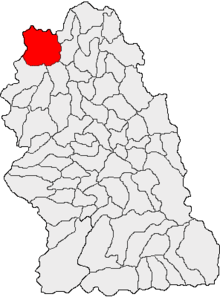Vața de Jos
|
Vața de Jos Alváca |
||||
|
||||
| Basic data | ||||
|---|---|---|---|---|
| State : |
|
|||
| Historical region : | Transylvania | |||
| Circle : | Hunedoara | |||
| Coordinates : | 46 ° 11 ' N , 22 ° 36' E | |||
| Time zone : | EET ( UTC +2) | |||
| Height : | 233 m | |||
| Area : | 202.63 km² | |||
| Residents : | 3,728 (October 20, 2011) | |||
| Population density : | 18 inhabitants per km² | |||
| Postal code : | 337514 | |||
| Telephone code : | (+40) 02 54 | |||
| License plate : | HD | |||
| Structure and administration (as of 2016) | ||||
| Community type : | local community | |||
| Structure : | Vața de Jos, Basarabasa , Birtin , Brotuna , Căzăneşti , Ciungani , Ocişor , Ociu , Prăvăleni , Prihodişte , Tătărăştii de Criş , Târnava de Criş , Vața de Sus | |||
| Mayor : | Milu Folescu ( PSD ) | |||
| Postal address : | Calea Crișului, no. 18 loc. Vața de Jos, jud. Hunedoara, RO-337514 |
|||
| Website : | ||||
Vața de Jos (outdated Varța de Jos ; Hungarian Alváca ) is a municipality in the district of Hunedoara in Transylvania , Romania .
The place is also known by the Hungarian names Alsóváca , Nagyváca and Alvaca-Fürdö .
Geographical location
The municipality Vața de Jos is located in the Brad depression ( Depresiunea Brad ), northeast of the Zarand Mountains ( Munții Zarandului ) on the upper reaches of the Crișul Alb ( White Screech ), a source river of the Körös . In the north of the Hunedoara district on the county road ( drum județean ) DJ 707, about two kilometers south of the European route 79 , the place is about 20 kilometers northwest of the small town of Brad ( Tannenhof ); the district capital Deva ( Diemrich ) is about 55 kilometers southeast.
3570 hectares of the community's 20,263 hectares are cultivated. Some of the twelve incorporated villages can only be reached on gravel roads.
history
About one kilometer north of Vața de Jos, in the Peştera Prihodişte cave also known as Hânzasca , archaeological finds that point to the Neolithic have been made.
An old bathing resort with simple facilities for bathtubs and an outdoor swimming pool was a main economic branch of the place. The artesian springs of the thermal bath have a temperature of 35 ° -38.5 ° C and a salt content of 1218 mg per liter. Today the bathing resort is closed.
population
Since the official census of 1850, mostly Romanians have been registered in the area of today's municipality . The highest population (7421) - also that of the Magyars (203) - was determined in 1910. The highest population of Romanians (7258) was in 1941 that the Roma (230) in 1850 and that of Romania German (27) registered the 1920s. Furthermore, were three in 1992 and 2002 Ukrainians , 1900 and 1910 each, and in 1930 three Serbs , 1890 a resident, in 1900 nine, in 1910 and 1930 three residents than Slovaks registered.
At the 2011 census, 3728 people were counted in 1543 households in the parish.
Attractions
In the place Vaa de Jos there are no noteworthy sights to be mentioned. The listed wooden churches and wooden houses in the incorporated villages are worth mentioning :
- In the village of Basarabasa the wooden church Sf. Nicolae in the 17th century; Petru Iocan's wooden house , built in 1890.
- In the incorporated village of Birtin, the wooden church Buna Vestire , built around 1690, the property of Isac Sabin , built in 1900, the wooden house by Minodora Gligor in 1906, that by Ioan Rus in 1910 and the wooden house by Carolina Lucaci , 1915.
- In the incorporated village of Căzăneşti , the wooden church Pogorârea Sf, built in the 18th century and enlarged in the 19th century, is a listed building . Duh , the wooden house by Elena Dudaș and Ioan Șerb, both built in 1810.
- In Ciungani the wooden church Buna Vestire , built around 1600, as well as the property of Rozalia Mateș and the wooden house of Anghelina Miclea, both built in 1800.
- In Ocişor, the wooden church Adormirea Maicii Domnului , built around 1802.
- In Ociu the wooden church Sf. Arhangheli , built 1750–1800.
Web links
Individual evidence
- ↑ 2011 census in Romania at citypopulation.de
- ^ Dictionary of the localities in Transylvania
- ↑ a b Heinz Heltmann, Gustav Servatius (Ed.): Travel Guide Siebenbürgen. Kraft, Würzburg 1993, ISBN 3-8083-2019-2 .
- ↑ a b List of historical monuments of the Romanian Ministry of Culture, updated 2010 (PDF; 7.10 MB)
- ↑ Web presentation of the municipality of Vața de Jos , accessed on March 26, 2013.
- ↑ Census, last updated November 2, 2008, p. 161 (Hungarian; PDF; 1.1 MB)
- ↑ Information on the church in Basarabasa from biserici.org accessed on March 26, 2013 (Romanian)
- ↑ Information on the church in Birtin from biserici.org accessed on March 27, 2013 (Romanian)
- ↑ Information on the church in Căzăneşti from biserici.org accessed on March 27, 2013 (Romanian)
- ↑ Information on the church in Ciungani from biserici.org accessed on March 27, 2013 (Romanian)
- ↑ Information on the church in Ocișor from biserici.org accessed on March 27, 2013 (Romanian)
- ↑ Information on the church in Ociu from biserici.org accessed on March 27, 2013 (Romanian)








